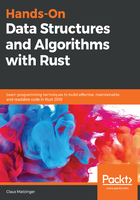
Interior mutability
Can a variable be immutable and mutable at the same time? Of course. Boxed variables (Box, Rc, and so on) are an immutable reference to the heap and they contain the actual value.
For these kinds of containers, there is no reason why the inner variable cannot be changed—a task that can be done safely in Rust using RefCell. RefCell maintains single ownership of a value but allows mutable borrowing checked at runtime. Instead of compiler errors, violating the rules of borrowing will lead to a runtime panic!, crashing the program.
This entire concept is called interior mutability and is often used in combination with Rc in order to provide a value to multiple owners with mutability at will. Clearly, to provide a great user experience, it is strongly recommended to make sure the borrowing rules can't be violated in other ways.
Wrapping a RefCell in an Rc acts as the gatekeeper for having multiple owners, including a way to change the contents. This is actually similar to more traditional programming languages such as Java or C#, where typically references are moved between method calls, pointing to the object's instance on the heap memory.
This pattern is very important for implementing complex programs and data structures, since ownership of a specific variable is not always clear. For example, later in the book we will examine doubly linked lists, which famously have a pointer to the preceding and succeeding node. Which node should have ownership of which pointer? Interior mutability allows us to say both. Consider the node declaration we will use later:
use std::cell::RefCell;
use std::rc::Rc;
#[derive(Clone)]
struct Node {
value: String,
next: Link,
prev: Link,
}
type Link = Option<Rc<RefCell<Node>>>;
With this list declaration, we can see the pattern in this simpler version of the append function:
pub fn append(&mut self, value: String) {
let new = Rc::new(RefCell::new(Node::new(value)));
match self.tail.take() {
Some(old) => {
old.borrow_mut().next = Some(new.clone());
new.borrow_mut().prev = Some(old);
}
None => self.head = Some(new.clone()),
};
}
This code adds a new node at the front (head) of the list, which contains all data in the form of nodes stored on the heap. In order to add a node at the head of the list, the references have to be set properly, so the previous and next pointers actually refer to the same nodes instead of copies. A more detailed exploration is going to be covered in Chapter 3, Lists, Lists, and More Lists. For now, the important part is setting the variables using borrow_mut(). This mutable reference only lives as long as the assignment takes, thereby ruling out creating a too-large scope and violating the borrowing rules.
By using the RefCell function's borrow_mut(), it will check for and enforce borrowing rules and panic in the case of a violation. Later on, we will also talk about the Mutex type, which is essentially a multithreaded version of these cells.